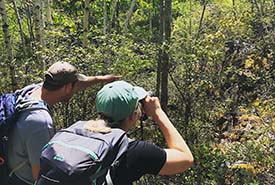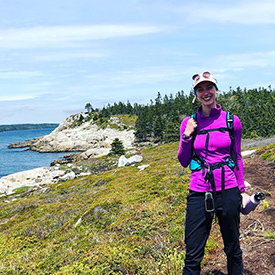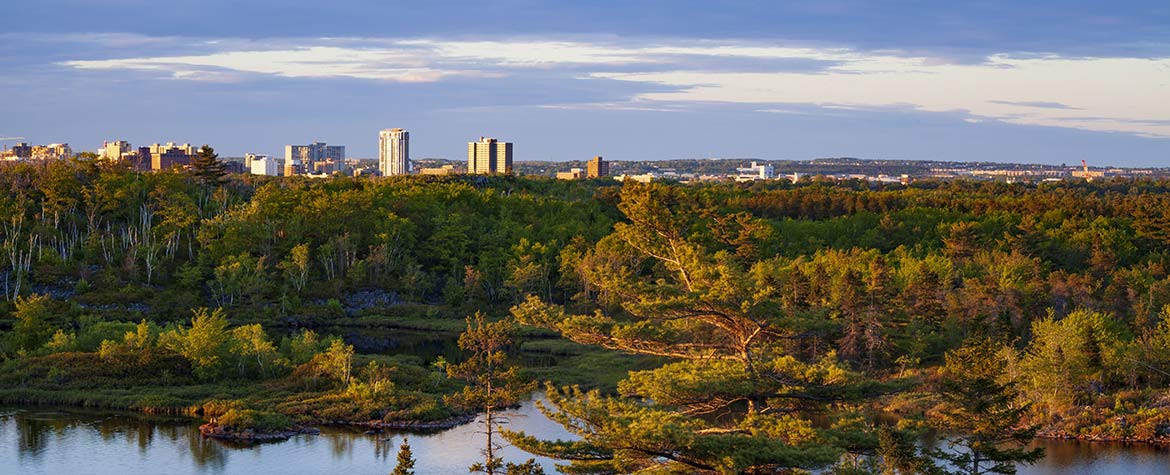A warm welcome back to nature

Samantha and Ben in the field, Shaw Wilderness Park, NS (Photo by NCC)
The change of season in Nova Scotia calls for new learning opportunities out in the field for nature enthusiasts like Samantha Stegen, getting back in the field, travelling across the province and hands-on learning is why she cherished her summer internship with the Nature Conservancy of Canada (NCC).
Although not her first field work experience, Samantha started the summer absorbing everything she could to be ready for the field season and some bushwhacking! With the mentorship of her supervisor, Doug van Hamessen, Samantha has also been able to work on a literature review of mouse-ear hawkweed to include in her portfolio when completing her master’s degree in the fall of 2021.
Excited to be back in nature, Samantha and the team visited the Shaw Wilderness Park to look for species at risk and make some important observations. The trip was a blast and full of beautiful scenery. As Samantha says: “this greenspace in the heart of the city did not disappoint.”
But a day out in the field also requires a lot of planning and preparation. There are a few important steps to take, including use a GPS to help with navigation, wear sunscreen and protective gear (gators to prevent tick bites), travel in groups, communicate your location with other team members before and after each trip, and carry enough drinking water.
While at the Shaw Wilderness Park, Samantha’s excitement grew as she found a few at-risk plants, including golden heather, pine barren, crowded sedge and mountain sandwort.
Monitoring and identifying at-risk species is a critical aspect of caring for lands. Information collected and observed help protect habitat for rare animals and plants for future generations. By recording the locations of important species, the team can make regular visits once a year to manage and maintain a healthy, diverse ecosystem.
Getting to the desired destinations is not as easy as it seems, at times. When the trails are not easily accessible, the team resorts to bushwhacking. This was the case in some remote areas of the Shaw Wilderness Park, where the team had to push through the trees and branches when navigating the more rugged backcountry areas. Wearing long-sleeved shirts and pants is a must in these situations. It is best to be ready for anything, as new opportunities for discovering plants and animals are not always readily available.

Samantha Stegen, 2021 Summer Intern, Dr. Bill Freedman Nature Reserve, NS (Photo by NCC)
While at the Shaw Wilderness Park, Samantha’s excitement grew as she found a few at-risk plants, including golden heather, pine barren, crowded sedge and mountain sandwort.
Monitoring and identifying at-risk species is a critical aspect of caring for lands. Information collected and observed help protect habitat for rare animals and plants for future generations. By recording the locations of important species, the team can make regular visits once a year to manage and maintain a healthy, diverse ecosystem.
Getting to the desired destinations is not as easy as it seems, at times. When the trails are not easily accessible, the team resorts to bushwhacking. This was the case in some remote areas of the Shaw Wilderness Park, where the team had to push through the trees and branches when navigating the more rugged backcountry areas. Wearing long-sleeved shirts and pants is a must in these situations. It is best to be ready for anything, as new opportunities for discovering plants and animals are not always readily available.
The day after visiting the Shaw Wilderness Park, the team travelled to another nature reserve to conduct the whole process all over again! This time at the Dr. Bill Freedman Nature Reserve, where a cool coastal breeze made it a perfect day for field work. Here, Samantha found more opportunities to learn and discover. The team quickly encountered ticks, and Samantha got to hold a baby tick the size of a breadcrumb — a treat for an arachnid lover!
Interns have the opportunity to learn about a wide variety of things when they are on-site at NCC properties. For example, Samantha learned the difference between moths and butterflies. The wing positioning is the most important differentiating feature between moths and butterflies; moths have flat wings, while butterfly wings perk up diagonally.
With lots of tree variations in the forest, it is not easy to identify every kind. Samantha learned a nifty trick from her colleagues to help her remember the difference between white pine and red pine. Samantha said, “Red pine splits off into two or three needles, while white pine splits into five needles. A quick way to tell white against red pine is to count the number of needles and remember that white is a five-letter word; therefore, white pine has five needles. “
When asked what made this internship meaningful for Samantha, she replied, “conserving natural areas for future generations, revitalizing habitats for current wildlife, working outdoors and being able to unplug from my devices.”
For future field days, Samantha hopes to learn from Indigenous communities in the area. She adds, “hearing Indigenous voices and their stories as the original stewards of the land and learning from the people who appreciate nature is what makes my heart sing. As a conservation biologist, I am learning just how important it is to engage Indigenous people in caring for the land. I think it is important to apply a two-eyed seeing approach, one that incorporates Indigenous Knowledge and western science.”





